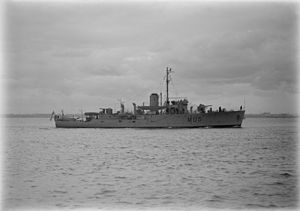| HMAS Colac | |
|---|---|
 HMAS Colac in 1952 | |
| Career (Australia) | |
| Namesake: | Town of Colac, Victoria |
| Builder: | Mort's Dock and Engineering Company |
| Laid down: | 18 April 1941 |
| Launched: | 30 August 1941 |
| Commissioned: | 6 January 1942 |
| Decommissioned: | 27 November 1945 |
| Recommissioned: | 20 February 1951 |
| Decommissioned: | 30 January 1953 |
| Out of service: | 1983 |
| Reclassified: |
Training ship (1951-1953) Tank cleaning ship (1962-1983) |
| Honours and awards: |
Battle honours:</ref>Pacific 1942-45 New Guinea 1942-44 |
| Fate: | Torpedoed by HMAS Ovens on 4 March 1987 in a weapons test |
| General characteristics | |
| Class & type: | Bathurst class corvette |
| Displacement: |
650 tons standard 1,025 tons full load |
| Length: | 186 ft (57 m) |
| Beam: | 31 ft (9.4 m) |
| Draught: | 8.5 ft (2.6 m) |
| Propulsion: | triple expansion engine, 2 shafts, 2,000 hp |
| Speed: | 15 knots (28 km/h; 17 mph) at 1,750 hp |
| Complement: | 85 |
| Armament: |
1 x 12-pounder gun (later replaced by 1 x 4-inch gun) 3 x 20 mm Oerlikons 1 x 40 mm Bofors (installed later) Machine guns Depth charges chutes and throwers |
HMAS Colac (J242/M05), named for the town of Colac, Victoria, was one of 60 Bathurst class corvettes constructed during World War II, and one of 36 initially manned and commissioned solely by the Royal Australian Navy (RAN).[1]
Construction[]
Colac was laid down by Mort's Dock and Engineering Company at Balmain, New South Wales on 18 April 1941.[1] She was launched on 30 August 1941 by Miss M. Heady, senior lady on the staff of Morts Dock and Engineering, and commissioned into the RAN on 6 January 1942.[1]
The ship was originally to be named HMAS Hamilton.[2]
Operational history[]
World War II[]
After entering service, Colac was assigned as an anti-submarine patrol and convoy escort vessel, operating between Townsville and New Guinea.[1] This continued until December 1942, when Colac and sister ships Ballarat and Broome were ordered to support the Allied efforts to recapture Buna-Gona by embarking 762 Australian soldiers and delivering them as far into the Japanese-occupied Oro Province of Papua New Guinea as possible.[1] The first attempt, early on 14 December, saw 46 soldiers landed at Cape Sudest before the three corvettes were attacked by Japanese aircraft and forced to withdraw.[1] That night, under the cover of darkness, the remaining troops were landed nearby.[1] Throughout December, Colac was involved in three similar troop deployments, and later took part in Operation Lilliput; the reinforcement and supply of the captured area.[1]
In March 1943, Colac and Ballarat were reassigned to convoy escort duty along the east coast of Australia.[1] On 26 April, a five-ship convoy escorted by the two corvettes was attacked by Japanese submarine I-177 off Cape Byron.[1] The MV Limerick was torpedoed and sunk, with all but two of the crew rescued by Colac. I-177 escaped unharmed.[1] In July, Colac was instructed to begin escorting convoys between Australia and New Guinea, before returning to east coast convoys at the start of 1944, then undergoing a refit.[1]
In April 1944, Colac was assigned to escort and patrol duties in New Guinea waters, which continued until April 1945, when the corvette was one of four RAN ships providing gunfire support for operations in the Wewak area.[1] In mid-May, Colac was assigned to harass Japanese bases in the Solomon Islands area. On 26 May, the ship suffered her first casualties of the war, two hits from Japanese shore batteries killed two sailers, wounded two others, and holed Colac at the waterline.[1] The corvette jettisoned stores, her depth charge payload, and replaceable pieces of equipment to avoid sinking and escape, and later limped to the Treasury Islands under tow for repairs.[1] Temporary repairs were made to allow Colac to sail to New Guinea and then to Sydney, where she arrived on 18 June and entered dock for repairs.[1] Colac was still under repair when World War II ended, and she was paid off into reserve on 27 November 1945.[1]
The corvette was awarded two battle honours for her wartime service: "Pacific 1942-45" and "New Guinea 1942-44".[3][4]
Training ship[]
On 20 February 1951, Colac was recommissioned for use as a training ship for National Service trainees.[1]
Decommissioning and fate[]
Colac was returned to reserve on 30 January 1953.[1] In 1962, the ship was converted into a tank cleaning vessel, and served in this role until 30 September 1983.[1] Colac was not recommissioned during this time.
On 4 March 1987, Colac was sunk by a Mark 48 torpedo fired by the submarine HMAS Ovens in a weapons test.[1] The corvette sank at 34°49.2′S 151°32′E / 34.82°S 151.533°E.[1]
References[]
- ↑ 1.00 1.01 1.02 1.03 1.04 1.05 1.06 1.07 1.08 1.09 1.10 1.11 1.12 1.13 1.14 1.15 1.16 1.17 1.18 1.19 1.20 1.21 "HMAS Colac". HMA Ship Histories. Sea Power Centre - Royal Australian Navy. Archived from the original on 5 February 2009. http://web.archive.org/web/20090205232236/http://www.navy.gov.au/HMAS_Colac. Retrieved 23 December 2008.
- ↑ Straczek, Joe (Winter 2003). "What's in a name: a chronological list - part 2". Australian Heritage Fleet. p. 13. ISSN 0813-0523.
- ↑ "Navy Marks 109th Birthday With Historic Changes To Battle Honours". Royal Australian Navy. 1 March 2010. Archived from the original on 13 June 2011. http://web.archive.org/web/20110613184920/http://www.navy.gov.au/Navy_Marks_109th_Birthday_With_Historic_Changes_To_Battle_Honours. Retrieved 23 December 2012.
- ↑ "Royal Australian Navy Ship/Unit Battle Honours". Royal Australian Navy. 1 March 2010. Archived from the original on 14 June 2011. http://web.archive.org/web/20110614064156/http://www.navy.gov.au/w/images/Units_entitlement_list.pdf. Retrieved 23 December 2012.
External links[]
| Wikimedia Commons has media related to HMAS Colac. |
| ||||||||||||||||||||||||
The original article can be found at HMAS Colac and the edit history here.